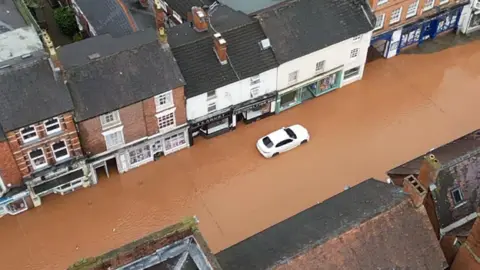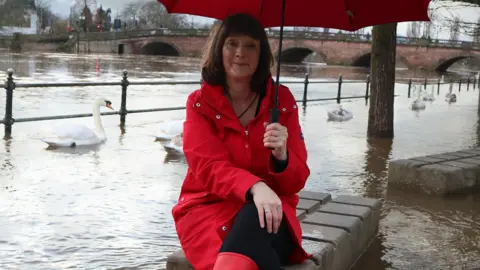How to prepare for floods when storms hit
 Darren Thompson
Darren ThompsonAs many communities across the country have been forced to deal with the aftermath of flooding this autumn, experts are warning people to make sure they are prepared for more this winter.
Downpours from Storm Bert caused flooding in places including Gloucestershire, Northamptonshire, Shropshire and Worcestershire.
Future flooding tips, which include how wellies can protect furniture and the benefits of a deflated children’s football, have been highlighted by experts.
They include flood resilience campaigner Mary Long-Dhonau, better known as Flood Mary, the Environment Agency (EA) and the National Flood Forum (NFF).
Ms Long-Dhonau, who was previously flooded twice in one year in Worcester, said the worst bit about being flooded was the recovery.
"Your average person is out of their home for nine months," she said.
"Your home is your sanctuary. You go there at the end of the day and you feel safe. When you have been flooded you feel completely violated."
Storm Conall came hot on the heels of Storm Bert, which also affected Somerset and Wiltshire and the Calder and Weaver valleys in the north of England, bringing flooding to the South and East.
The EA, the lead organisation for managing flooding and responding to flooding incidents in England, urged people at risk to "take control and be ready".
 Flood Mary
Flood MaryHow to be ready for flooding
Items from around your home could be used to prepare for flooding, according to Ms Long-Dhonau, who added there were affordable steps people could take for protection.
Aluminium tape can be used on air bricks in outside walls to hold back water if people do not have self-closing ones or covers.
Kitchen tables can be protected by standing the legs in welly boots and buckets, she added.
Dry food should be kept safe in plastic, lidded boxes.
Ms Long-Dhonau said people should take sentimental items such as family photographs - anything “that would break your heart to lose” - and put them in a box upstairs.
People living in bungalows can find a "flood buddy" to store their items or place boxes on wardrobes or in a loft.
A deflated children’s football in the toilet can stop sewage coming back up and while "it’s not as good as a bung or non-return valve" it was better than nothing, she added.
Homeowners should also make sure their insurance cover is adequate, the NFF said.
The Environment Agency said: "Getting ready before a flood saves you money on recovery and time spent out of the property."
It said planning ahead for flooding was straightforward, quick and free and people should draw up a "personal flood plan" to keep themselves and their vital possessions safe.
Local resilience forums also help people to prepare.
 Reuters
ReutersWhat can I do when flooding is expected?
Weather warnings are issued by the Met Office through its website while people can sign up to the Environment Agency for warnings and forecasting alerts, Tracey Garrett, from the NFF said.
The EA also urged all property owners at risk of river flooding to sign up to its free flood warning service and for those at risk of surface water flooding, to sign up to Met Office weather alerts.
Councils such as Shropshire, Worcestershire and Herefordshire, all near the River Severn, said they posted updates on their websites during flooding including steps people can take to make plans.
People may think of getting sandbags to protect their home from floods, given their widespread use in the past, however authorities including the Environment Agency and local authorities said they no longer have a statutory duty to provide them.
Advice on how to use sandbags was withdrawn in 2020, with the recommendation instead that people should install property flood resilience products instead.
Ms Long-Dhonau said she would also caution over their use.
“I think it goes back to the war, building sandbags walls. They are a sort of a comfort blanket," she added.
"They are also heavy, environmentally unfriendly and have to be disposed of in contaminated waste."
 Flood Mary
Flood MaryHow to stay safe during a flood
Advice during a flood was for people to first make sure they and their families were safe, the NFF said.
People should be prepared for evacuations and have a grab bag ready containing medication, forms of ID, cash, bank cards , passports, details of prescriptions – “thing you would need if you can’t get back for some time”.
Ms Long-Dhonau also said people should follow evacuation advice if told to leave their homes.
She added many floods were short-lived and it was possible to stay but always follow official advice.
Listen to local BBC radio stations, local TV bulletins and follow BBC Online alongside what the emergency services say, she added.
The Environment Agency has a hotline for reporting flooding.
Its checklist for what action to take during an incident include:
- Phone 999 if in immediate danger
- Move families and possessions to a high place
- Check vulnerable people and neighbours are safe
- Turn off gas and electricity before flooding enters the property
- Fill jugs and saucepans with supplies of clean water
 Flood Mary
Flood MaryWhat should I do after a flood?
After a flood, water levels can rise and fall for several weeks, the Environment Agency warned.
Safety advice is to avoid entering floodwater unless absolutely necessary because it can be deeper than it appears and it may hide dangers such as uncovered manholes and sharp objects.
Anyone who does enter floodwater should move slowly and carefully and avoid fast-moving water, the agency said.
People should wash their hands regularly to remove harmful bugs and chemicals found in floodwater, sewage or items left in water. Use warm, soapy water and rinse and dry hands thoroughly.
When it comes to tackling flood damage, people should contact their insurers, making notes of who they speak to, take photographs and check with insurers before moving anything, the NFF said.
People who do not have insurance can contact their council for information on hardship grants and charities.
In the long-term, Ms Long-Dhonau advised people who claimed on their insurance for flood damage to think about incorporating flood recovery and future protection into repairs.
Changes include moving plug sockets higher up walls, flood doors and plastic flooring.
She said help was also available as part of Flood Re, a scheme designed to provide affordable insurance for flood-risk homes.
The Environment Agency added that Flood Re could reduce insurance costs and give homeowners access to affordable insurance premiums.
NFF advice to people considering flood resilience measures at home was to get expert advice from a qualified surveyor because work could be costly.
Some flood doors can cost between £5,000 and £10,000.
All those who were flooded were encouraged to report it to their local authority so there was more chance of councils getting government funds to support residents, an NFF spokesperson added.
Flooding mental health
The Environment Agency also urged people to look after themselves after cases of flooding.
It is vital to speak to children about how they are feeling and to reassure them they are safe, a spokesperson added.
"Mental health can be the last thing we think about after a flood when there are urgent matters that require our attention," they added.
"Remember: flooding is stressful. It is normal to feel tired, anxious and have difficulty sleeping.
"It is important to ask yourself how you are feeling and to reach out to friends, family or neighbours if you are feeling stressed or overwhelmed."
People could also consider becoming a flood warden in future.
Flood wardens helped to raise awareness in the community, inform authorities of blockages that could cause flooding, report issues to councils and provide a link between the agency and at-risk communities, the spokesperson said.
Follow BBC Hereford & Worcester on BBC Sounds, Facebook, X and Instagram.
